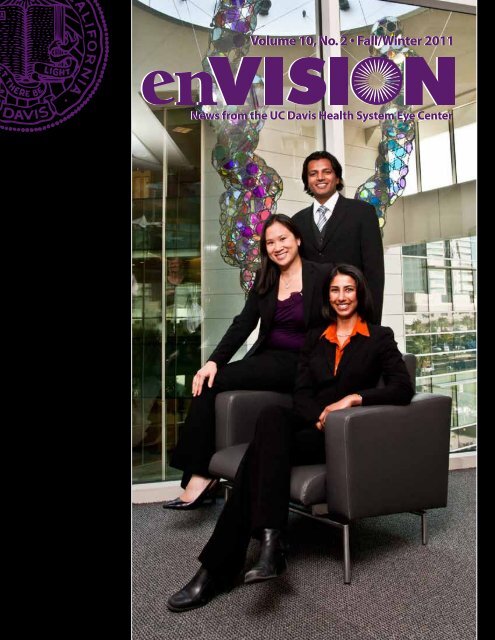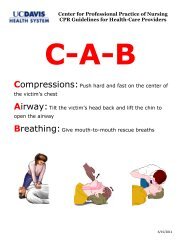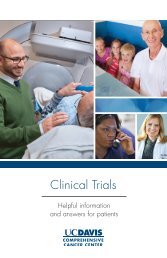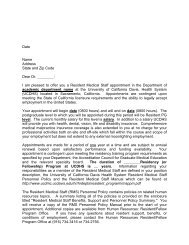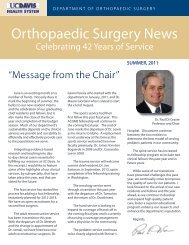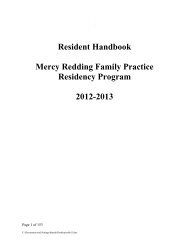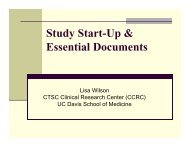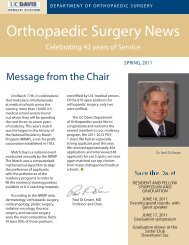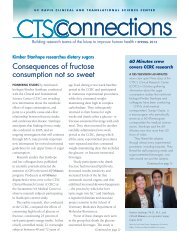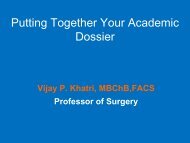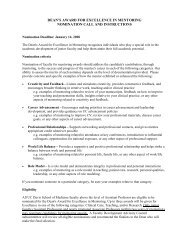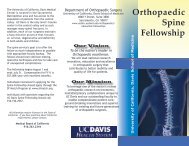enVISION Fall 2011 - UC Davis Health System
enVISION Fall 2011 - UC Davis Health System
enVISION Fall 2011 - UC Davis Health System
Create successful ePaper yourself
Turn your PDF publications into a flip-book with our unique Google optimized e-Paper software.
Volume 10, No. 2 • <strong>Fall</strong>/Winter <strong>2011</strong><br />
News from the <strong>UC</strong> <strong>Davis</strong> <strong>Health</strong> <strong>System</strong> Eye Center
Byron Demorest, M.D.,<br />
Founding Chair of the <strong>UC</strong> <strong>Davis</strong><br />
Department of Ophthalmology<br />
By Mark J. Mannis, Professor of Ophthalmology and Chair, <strong>UC</strong> <strong>Davis</strong> Eye Center<br />
This year, we lost one of the great leaders of American<br />
ophthalmology and surely Sacramento’s pre-eminent<br />
practitioner. We celebrate the remarkable life of our dear<br />
friend, colleague and teacher, Byron Demorest. Many<br />
wonderful things, all well-deserved, can be said about Byron<br />
and his very special role in the ophthalmic community of<br />
our region.<br />
He was a true visionary with a “can do” attitude– the attitude<br />
that fueled his founding of the Department of Ophthalmology<br />
at <strong>UC</strong> <strong>Davis</strong>. While dedicated to quality medical care in<br />
the private sector, he recognized, early on, the need for<br />
an academic center of ophthalmology in the State Capital.<br />
Serving as the founder and first chair of the department, he<br />
forged a strong bond between the community of practitioners<br />
and <strong>UC</strong> <strong>Davis</strong>, an institution to which he was dedicated<br />
throughout his career. The fledgling department that he<br />
began in the mid-1960s--now the <strong>UC</strong> <strong>Davis</strong> Eye Center--has<br />
over 20 full-time clinicians and research faculty and has<br />
become one of the premier training programs in the country.<br />
In the days following his passing, many colleagues called<br />
and wrote the Department to share their memories of Dr.<br />
Demorest. One individual wrote: “Byron Demorest was the<br />
epitome of focused, positive energy as a physician, a teacher,<br />
| 02 | Byron Demorest, M.D.<br />
and a human being...<br />
He lived his life as we all<br />
should: sharing, inspiring,<br />
and loving everything he<br />
did and everyone around him...We are very blessed to have<br />
been part of his world...”<br />
In addition to his role with <strong>UC</strong> <strong>Davis</strong>, Dr. Demorest was a<br />
skilled and admired pediatric ophthalmologist with a busy<br />
practice in Sacramento. He was also a national leader in the<br />
ophthalmology field. He served as an associate examiner for<br />
the American Board of Ophthalmology and was a leader in<br />
many professional groups, including the California<br />
Academy of Eye Physicians and Surgeons and as president of<br />
the American Academy of Ophthalmology. In 1973, he was<br />
president of the Sacramento County Medical Society.<br />
Byron’s booming voice that for decades signaled the start<br />
of Grand Rounds at <strong>UC</strong> <strong>Davis</strong> will not be forgotten nor will<br />
his candor and unflinching insistence in the ophthalmic<br />
community on doing the right thing by our patients and our<br />
community.<br />
Byron’s legacy will reverberate through the coming decades,<br />
as the many residents in whose training he participated and<br />
the colleagues with whom he shared the practice of our<br />
profession in Sacramento carry on what he taught us --in his<br />
practice, the lecture hall, grand rounds, the Alta Society, and<br />
as a leader of organized American ophthalmology.<br />
We are all grateful and better to have known and worked with<br />
Byron Demorest, and we extend our condolences to Phyllis, his<br />
wife of 64 years, his three children, and all of his family.
The Unique Experience of Receiving Care<br />
at a Teaching Hospital<br />
In the midst of busy clinics, when I am followed into a room by<br />
a retinue of residents, fellows, and medical students, patients<br />
will often ask me about how teaching hospitals work: “Why do I<br />
have to see another doctor before I see Dr. Mannis?”; “Are these<br />
guys really doctors? (They seem so young)”; “Do you check<br />
everything that they do to make sure it is correct?”; and perhaps<br />
the most common question, “Is the young doctor going to be the<br />
one who does my surgery or are you going to do my surgery, Dr.<br />
Mannis?”.<br />
There is no question that receiving care at a “teaching hospital”<br />
is a different experience from visiting a private practitioner’s<br />
office. Like everything, it has some advantages and some<br />
disadvantages. From the patient’s standpoint, one disadvantage<br />
is that it is rarely as efficient and streamlined as a visit to a<br />
private office. There is the repetition of examinations, time taken<br />
for discussion and demonstrations, and often additional testing<br />
that might not be available in a private office. That is the price<br />
of teaching. Among the list of advantages, on the other hand,<br />
is that the patient benefits from the expertise of highly-trained<br />
specialists and receives what is essentially several “ second<br />
opinions” during the course of the examination.<br />
Here at the <strong>UC</strong> <strong>Davis</strong> Eye Center, teaching is a centerpiece of our<br />
program. Trainees at every level–medical students, residents,<br />
clinical fellows, and researchers–are part of our mission to<br />
educate the next generation of eye care practitioners and vision<br />
scientists. They are carefully chosen to study here, while also,<br />
providing the very best in clinical care under direct faculty<br />
supervision.<br />
What are our teaching responsibilities? At the level of our<br />
medical students, we offer training in basic ophthalmic<br />
examination skills, and, for those who elect to enhance their<br />
ophthalmic education, rotations in basic or more advanced<br />
ophthalmology or vision<br />
research. Our residents,<br />
after completing medical<br />
school and a year of<br />
internship in general medicine, spend three years with us,<br />
training in all aspects of medical and surgical ophthalmology,<br />
equipping them to leave <strong>UC</strong>D as very competent comprehensive<br />
ophthalmologists. And our fellows, training in the specialties<br />
of cornea, glaucoma, or retina, spend 1-2 years after residency<br />
becoming very specialized experts in their field.<br />
But teaching at the Eye Center is not limited to the clinic. Our<br />
program also has a National Eye Institute-funded Training<br />
Grant, and many of our basic researchers have doctoral and<br />
post-doctoral students training in the techniques of basic vision<br />
science.<br />
So, what this means is that the patient who comes to the <strong>UC</strong><br />
<strong>Davis</strong> Eye Center enters a place where curiosity, transmission<br />
of information, the newest clinical and the most sophisticated<br />
scientific techniques blend with compassionate care. This blend<br />
provides both the highest level of clinical service as well as the<br />
real possibility that unsolved problems may find a solution in this<br />
place. Although more costly and less streamlined than private<br />
health care delivery, we strongly believe that the nurturing of<br />
inquisitive minds is an added value for our patients. Teaching<br />
at the Eye Center is only an extension of the amazing resources<br />
provided by the <strong>Health</strong> <strong>System</strong> and by the University in general.<br />
But we view our investment in the future of eye care as a very<br />
important mission and one in which we will surely continue to<br />
invest.<br />
Mark J. Mannis, MD, FACS<br />
From the Chair’ s Desk<br />
<strong>Fall</strong>/Winter <strong>2011</strong> www.ucdmc.ucdavis.edu/eyecenter | 03 |
| 04 |<br />
is published by the <strong>UC</strong> <strong>Davis</strong><br />
<strong>Health</strong> <strong>System</strong> Eye Center. For<br />
more information about<br />
ophthalmology services and vision<br />
research at<br />
<strong>UC</strong> <strong>Davis</strong>, visit our Web site at:<br />
www.ucdmc.ucdavis.<br />
edu/eyecenter<br />
or call (916) 734-6435.<br />
Managing Editors<br />
Mark J. Mannis, M.D.<br />
Ernest Phinney<br />
Contributing Editors<br />
Kim Angelo<br />
Barbara Holderreed<br />
Contributors<br />
Mark J. Mannis, M.D.<br />
Annie K. Baik, M.D.<br />
Lawrence S. Morse, M.D.<br />
Charles Weber, M.D.<br />
Ernest Phinney<br />
Production Manager<br />
Holland Adams<br />
Photography<br />
Bhupinder S. Dhillon<br />
Emi Manning<br />
Design/Layout<br />
Steven A. Osborne<br />
Vision<br />
Our vision is to be the world’s<br />
transformational leader in<br />
collaborative vision research and<br />
in the development of cures for<br />
blinding eye disease from cornea<br />
to cortex.<br />
Mission<br />
We will realize our vision through<br />
pioneering collaborative vision<br />
research, providing state-ofthe-art,<br />
world-class eye care,<br />
and training superbly prepared<br />
ophthalmologists and vision<br />
scientists.<br />
Directory<br />
<strong>UC</strong> <strong>Davis</strong> <strong>Health</strong> <strong>System</strong> Eye Center<br />
4860 Y St., Suite 2400<br />
Sacramento, CA 95817<br />
<strong>UC</strong> <strong>Davis</strong> Eye Center Optical Shop<br />
4860 Y St., Suite 2013<br />
Sacramento, CA 95817<br />
(916) 734-6300<br />
<strong>UC</strong> <strong>Davis</strong> Medical Group, Roseville<br />
2261 Douglas Blvd.<br />
Roseville, CA 95661<br />
<strong>UC</strong> <strong>Davis</strong> Eye Services<br />
77 Cadillac Dr.<br />
Sacramento, CA 95825<br />
To Schedule Patient Appointments:<br />
(916) 734-6602 (Patient All Sites)<br />
(916) 734-6992 (FAX)<br />
(916) 734-6650 (Laser Vision Correction Services)<br />
2010 Donor List Corrections:<br />
Visionary Gold ($100,000+)<br />
Macular Degeneration Foundation, Inc.<br />
Visionary Silver ($50,000+)<br />
Foundation Fighting Blindness<br />
Senior Counselor $(5,000+)<br />
Eye Bank Association of America<br />
Chair’s Council 2010 ($1,000+)<br />
Ann L. Kerr<br />
Silver Circle (100+)<br />
Kevin Chang, D.D.S. and Brooke Chang, O.D.<br />
Mary Beth Tasker, M.D. Research Fund<br />
Barbara Arnold, M.D. & Henry Go, M.D.
02<br />
18<br />
30<br />
38<br />
Contents<br />
02 Byron Demorest, M.D., Founding Chair<br />
Byron Demorest, M.D., Founding Chair of the<br />
<strong>UC</strong> <strong>Davis</strong> Department of Ophthalmology<br />
03 From the Chair’s Desk<br />
The Unique Experience of Receiving Care at a Teaching<br />
Hospital<br />
06 <strong>UC</strong> <strong>Davis</strong> Eye Team<br />
18 New Faculty Welcomed<br />
Three New Faculty Members Join Eye Center in <strong>2011</strong><br />
21 A New Faculty Publication<br />
22 Residents, Faculty & Fellows Honors and Awards<br />
23 Eye Center Donor Profile<br />
Bonnie Dale, a One Woman Crusade for Glaucoma<br />
Support Groups<br />
24 Volunteer Clinical Faculty Profilee<br />
Providing Hope for Low Vision Patients:<br />
Ronald Cole, <strong>UC</strong> <strong>Davis</strong> Volunteer Clinical Faculty<br />
25 Research to Prevent Blindness<br />
The Indispensable Funder of Vision Research<br />
26 The Eye Center Residency Program<br />
Producing Exceptionally Well-prepared<br />
Ophthalmologists<br />
28 Eye Center Council Update<br />
29 Pan-American Association of Ophthalmology<br />
Mannis Elected President of the Pan-American Association<br />
of of Ophthalmology<br />
30 Africa and Back<br />
32 Hail Fellow, Well-Trained<br />
Ophthalmology Fellows are the Most Advanced Students<br />
at at <strong>UC</strong> <strong>Davis</strong> Eye Center<br />
34 4th annual Sacramento Homeless Connect<br />
Event<br />
<strong>UC</strong> <strong>Davis</strong> Eye Center residents volunteer at the 4th annual<br />
Sacramento Homeless Connect Event<br />
36 A Vision of the Future<br />
Medical Students, Their Education and The Eye Center<br />
37 Multidisciplinary Perspective<br />
National Eye Institute (NEI) Grant<br />
Provides Critical Support for Training New Vision Scientists<br />
38 Crocker<br />
Crocker Art Museum Hosts Spring <strong>2011</strong> Werner<br />
Lecture Series
| 06 | Chair and Vice-Chair<br />
Professor and Chair<br />
Mark J. Mannis, M.D., F.A.C.S.<br />
Director, Cornea Service.<br />
Research Interests: Corneal Transplant<br />
Technology, Eye & Skin Diseases, &<br />
Artificial Corneas.<br />
Dr. Mannis, Professor and Chair of the <strong>UC</strong> <strong>Davis</strong> <strong>Health</strong> <strong>System</strong> Eye Center,<br />
specializes in corneal transplantation and external diseases of the eye. His<br />
residency was completed at Washington University, St. Louis, Missouri, and<br />
his cornea and external eye disease fellowship was completed at University<br />
of Iowa, Iowa City, Iowa. His research has included the development of<br />
experimental antimicrobial agents and growth factors that affect the corneal<br />
wound healing rate, skin diseases that affect the eye, and outcomes of<br />
corneal transplants and artificial corneas. Dr. Mannis has authored over 125<br />
publications and five books on topics relating to corneal surgery and disease.<br />
Associate Professor and<br />
Vice-Chair<br />
Michele C. Lim, M.D..<br />
Associate Professor, Glaucoma,<br />
Vice-Chair, Medical Director.<br />
Research Interests: Drug delivery in<br />
glaucoma drops and patient compliance.<br />
Dr. Lim specializes in the medical and surgical treatment of glaucoma in both<br />
children and adults. As Vice-Chair and Medical Director for the department,<br />
she oversees clinic operations. Dr. Lim completed her ophthalmology<br />
residency at <strong>UC</strong>LA’s Jules Stein Institute and a fellowship at the University<br />
of Miami’s Bascom-Palmer Eye Institute. Dr. Lim believes that patients and<br />
their physicians should work together as a team to achieve their treatment<br />
goals. The more information a patient has regarding his or her disease, the<br />
more involved that patient will be in their own medical care. She encourages<br />
patients to ask questions about their glaucoma eye care in order to stay<br />
informed. Her research has focused on medication adherence (whether a<br />
patient takes their medication on schedule) among glaucoma patients.
Annie K. Baik, M.D.<br />
Assistant Clinical Professor,<br />
Glaucoma, Veterans<br />
Administration, Mather.<br />
Research Interests: Emerging<br />
glaucoma surgical techniques,<br />
patient education.<br />
Dr. Baik is a glaucoma specialist, treating both adults and children.<br />
She holds joint appointments at <strong>UC</strong> <strong>Davis</strong> Eye Center and the<br />
Sacramento Veterans Affairs Medical Center, Mather. After completion<br />
of her residency at University of Texas, Houston, Dr. Baik completed<br />
a glaucoma fellowship here at <strong>UC</strong> <strong>Davis</strong>. Her connection with <strong>UC</strong><br />
<strong>Davis</strong> inspired her to return to the academic community. Dr. Baik<br />
is committed to resident education and mentorship as well as<br />
patient education and collaborative clinical care. In the past, she has<br />
presented her research at the American Glaucoma Society, and she<br />
retains an active interest in advances in the surgical management of<br />
glaucoma.<br />
Jeffrey J. Caspar, M.D.<br />
Clinical Professor, Comprehensive<br />
Ophthalmology and Refractive<br />
Surgery, Residency Program<br />
Director.<br />
Research Interests: Improvement<br />
of techniques in cataract surgery.<br />
Dr. Caspar is a comprehensive ophthalmologist, treating a wide<br />
variety of ophthalmic disorders. He specializes in small-incision<br />
cataract surgery using the latest technologies, including multifocal<br />
and astigmatism-correcting lens implants. He also specializes in laser<br />
vision correction, including custom and conventional LASIK, PRK,<br />
LASEK and clear-lens extraction. He is involved in research on cataract<br />
surgery after refractive surgery and new techniques for cataract<br />
extraction. Dr. Caspar helps train other ophthalmologists in advanced<br />
cataract surgery techniques and refractive surgery. Dr. Caspar<br />
completed his residency at <strong>UC</strong> <strong>Davis</strong>.<br />
Ophthalmologists<br />
James D. Brandt, M.D.<br />
Professor, Glaucoma,<br />
Director, Glaucoma Service.<br />
Research Interests:<br />
Nanotechnology<br />
for innovation in glaucoma<br />
treatments.<br />
Dr. Brandt specializes in medical and surgical treatments of glaucoma<br />
in adults and children. His residency was completed at the University<br />
of Southern California after which he completed fellowships at Wills<br />
Eye Hospital and Harvard Medical School-Eye Research Institute. Dr.<br />
Brandt has research interests in both the clinical and basic realms. He<br />
is actively involved in large clinical trials investigating new medical and<br />
surgical treatments of glaucoma and new technologies for diagnosing<br />
the disease. In the basic research arena, Dr. Brandt is currently<br />
collaborating with Dr. Tingrui Pan of the Department of Biomedical<br />
Engineering to develop new MEMS and Nanotechnology-based devices<br />
for the diagnosis of glaucoma.<br />
Francisco J. Garcia-Ferrer, M.D.<br />
Associate Professor, Cornea,<br />
External Disease and Refractive<br />
Surgery, Veterans Administration,<br />
Mather.<br />
Research Interests: New<br />
technology for refractive<br />
surgery.<br />
Dr. Garcia-Ferrer specializes in cornea, external disease and refractive<br />
surgery. As chief of the eye section at the Sacramento VA Medical<br />
Center, Dr. Garcia-Ferrer is involved in advanced cataract surgery<br />
techniques, corneal transplantation, and the medical management of<br />
glaucoma and retinal diseases. His <strong>UC</strong> <strong>Davis</strong> practice focuses exclusively<br />
on keratorefractive surgery, including LASIK and PRK. Dr. Garcia-<br />
Ferrer’s research interests have included the development of molecular<br />
techniques to diagnose corneal infections. Current interests include<br />
developing new strategies to improve patient access to care and clinic<br />
efficiency.<br />
<strong>Fall</strong>/Winter <strong>2011</strong> www.ucdmc.ucdavis.edu/eyecenter | 07 |
Nandini Gandhi, M.D.<br />
Assistant Professor, Pediatric<br />
Ophthalmology and Strabismus.<br />
Research Interests:<br />
International ophthalmology<br />
and curriculum development<br />
abroad.<br />
Dr. Gandhi joined the <strong>UC</strong> <strong>Davis</strong> faculty after completing her<br />
fellowship in pediatric ophthalmology and strabismus at the Duke<br />
Eye Center. Her commitment to academic medicine is born of her<br />
interest in teaching and medical education. She is also interested<br />
in international ophthalmology and curriculum development<br />
abroad. Her current clinical interests include comprehensive<br />
pediatric ophthalmology and adult strabismus.<br />
Syed Khizer Khaderi, M.D., M.P.H.<br />
Assistant Professor,<br />
Neuro-Ophthalmology.<br />
Research Interests: Genetic<br />
diseases of the optic nerve<br />
and visual psychophysics.<br />
Dr. Khaderi joined the Eye Center after completion of a Neuro-<br />
Ophthalmology Fellowship at the Doheny Eye Institute, University<br />
of Southern California. His residency was completed at the<br />
University of Arizona College of Medicine. Dr. Khaderi’s research<br />
focuses on genetic diseases of the optic nerve and on visual<br />
psychophysics. Dr. Khaderi owns several patents related to retinal<br />
ganglion expression and visual software algorithms, which assist<br />
him in his research.<br />
| 08 | Ophthalmologists<br />
John L. Keltner, M.D.<br />
Professor, Chair Emeritus<br />
Neuro-Ophthalmology,<br />
Research Director.<br />
Research Interests: The effects of<br />
multiple sclerosis (MS) and cancer<br />
on vision.<br />
Dr. Keltner is an internationally known Neuro-ophthalmologist, who<br />
specializes in the diagnosis and treatment of complex unexplained<br />
neurological abnormalities affecting visual pathways. He completed<br />
residencies in ophthalmology, neurology, and internal medicine and<br />
fellowships in pediatric-ophthalmology and neuro-ophthalmology.<br />
He served as Chair of the <strong>UC</strong> <strong>Davis</strong> Department of Ophthalmology<br />
and Vision Science for over 25 years, and he is currently the Director<br />
of Research and Faculty Development for the <strong>UC</strong> <strong>Davis</strong> Eye Center.<br />
Dr. Keltner has many research interests, for example, autoimmunerelated<br />
retinopathies, optic neuropathies that affect vision, and<br />
Multiple Sclerosis and its affect on vision.<br />
Esther S. Kim, M.D.<br />
Associate Clinical Professor,<br />
Comprehensive Ophthalmology,<br />
Director, Optometric Services.<br />
Research Interests:<br />
Improvement of<br />
technology in cataract surgery.<br />
Dr. Kim is a comprehensive ophthalmologist, specializing in<br />
cataract surgery. She completed medical school and residency at<br />
<strong>UC</strong> <strong>Davis</strong>. Dr. Kim chose to stay in academic medicine and teach<br />
the next generation of ophthalmologists. She is also the Director of<br />
Optometric Services. Her research interests include the improvement<br />
of technology in cataract surgery.
Linda J. Margulies, M.D.<br />
Clinical Professor, Vitreoretinal<br />
Disease, Veterans<br />
Administration, Martinez.<br />
Research Interests: New<br />
treatment for age-related macular<br />
degeneration.<br />
Dr. Margulies specializes in vitreoretinal diseases and surgery.<br />
She completed her ophthalmology residency at <strong>UC</strong> <strong>Davis</strong> and a<br />
fellowship in vitreoretinal disease at Washington University in St.<br />
Louis, Missouri. She has been associated with <strong>UC</strong> <strong>Davis</strong> as a faculty<br />
member since 1988 and works extensively with ophthalmology<br />
residents at the Veterans Administration Hospital in Martinez,<br />
California, where she is Director of the Ophthalmology Program.<br />
Lily Koo Lin, M.D.<br />
Assistant Professor,<br />
Oculoplastic Surgery.<br />
Research Interests: Improvement<br />
of aging eyelids.<br />
Dr. Koo Lin specializes in ophthalmic plastic and orbital surgery,<br />
including disorders of the orbit and lacrimal drainage system as well<br />
as cosmetic and reconstructive surgery of the eyelids and eyebrows.<br />
Her research includes improvement of aging eyelids and the orbital<br />
globe relationship and trauma. Dr. Koo Lin completed her residency<br />
in ophthalmology at Harvard Medical School and completed an<br />
ophthalmic plastic, orbital, and reconstructive surgery fellowship<br />
at Doheny Eye Institute in Los Angeles, California. Dr. Koo Lin is a<br />
board- certified ophthalmologist and a member of the American<br />
Society of Ophthalmic Plastic and Reconstructive Surgery.<br />
Ophthalmologists<br />
Jennifer Li, M.D.<br />
Assistant Professor, Cornea,<br />
External Disease and Refractive<br />
Surgery.<br />
Research Interests:<br />
Endothelial keratoplasty and<br />
keratoprosthesis surgery.<br />
Dr. Jennifer Li joined the Eye Center in August as a specialist in<br />
cornea, external disease and refractive surgery. Dr. Li received her<br />
medical degree and ophthalmology residency at the Baylor College of<br />
Medicine in Houston, Texas and subsequently completed her cornea<br />
fellowship at <strong>UC</strong> <strong>Davis</strong>. Following her training, she practiced at the<br />
Devers Eye Institute in Portland, Oregon. Her research on corneal<br />
surgery, including endothelial keratoplasty and keratoprosthesis<br />
surgery, has been presented nationally and internationally.<br />
Committed to patient care, research and education, Dr. Li looks<br />
forward to rejoining the academic community at <strong>UC</strong> <strong>Davis</strong> and the<br />
Sacramento ophthalmic community.<br />
Lawrence S. Morse, M.D., Ph.D.<br />
Professor, Vitreoretinal Surgery<br />
and Uveitis, Director,<br />
Retina Service.<br />
Research Interests: Treatments<br />
for diabetic retinopathy,<br />
age-related macular<br />
degeneration and retinal<br />
degeneration.<br />
Dr. Morse is the Director of the VitreoRetinal Service and specializes<br />
in vitreoretinal disease and surgery with an emphasis on macular<br />
degeneration. He completed his Ph.D. in Virology at University of<br />
Chicago and continued his education, completing his ophthalmology<br />
residency at Jules Stein Eye Institute, <strong>UC</strong>LA and his retina fellowship<br />
at Duke University. In addition to his clinical work, Dr. Morse has<br />
been involved with over 20 clinical studies. He has also authored over<br />
120 publications, been invited to teach at over 85 courses and spoke<br />
at over 100 meetings around the world.<br />
<strong>Fall</strong>/Winter <strong>2011</strong> www.ucdmc.ucdavis.edu/eyecenter | 09 |
Mary A. O’Hara, M.D., F.A.C.S.,<br />
F.C.A.P.<br />
Professor,<br />
Pediatric Ophthalmology.<br />
Research Interests: Development<br />
of new technology in pediatric<br />
strabismus.<br />
Dr. O’Hara is the Director of Pediatric Ophthalmology. She<br />
specializes in pediatric ophthalmology, treating amblyopia and<br />
strabismus, cataracts, anterior segment disorders, and adult<br />
strabismus. Dr. O’Hara completed her ophthalmology residency<br />
at Brooke Army Medical Center and her pediatric ophthalmology<br />
and strabismus fellowship at Wills Eye Hospital, Philadelphia,<br />
Pennsylvania. Her clinical research interests include amblyopia<br />
and motility disorders.<br />
Alan M. Roth, M.D.<br />
Professor Emeritus, Ophthalmic<br />
Pathology.<br />
Dr. Roth is active in pathology research. He completed two<br />
residencies, the first residency in ophthalmology at the Veterans’<br />
Administration Hospital, Long Beach; the second residency in<br />
pathology at <strong>UC</strong>LA. He also completed an NIH Special Fellowship<br />
in ophthalmic pathology at Jules Stein Eye Institute, Los Angeles.<br />
| 10 | Ophthalmologists<br />
Susanna S. Park, M.D., Ph.D.<br />
Professor, Vitreoretinal Surgery.<br />
Research Interests: Proton beam<br />
treatments for age-related<br />
macular degeneration, anti-VEGF<br />
treatment for age-related macular<br />
degeneration, retinal imaging and<br />
stem cell therapies for age-related<br />
macular degeneration.<br />
Dr. Park is a vitreoretinal specialist who provides both surgical and<br />
medical management of all vitreoretinal disorders including macular<br />
degeneration, diabetic retinopathy, retinal detachment, posterior<br />
uveitis and trauma. She also treats patients with intraocular tumors<br />
including the use of proton beam irradiation for ocular melanomas and<br />
chemotherapy for retinoblastomas. She completed her ophthalmology<br />
residency and retinal fellowship at Massachusetts Eye & Ear Infirmary at<br />
Harvard University. Dr. Park is interested in using new imaging techniques<br />
to study macular disorders and in developing new treatments for retinal<br />
disorders including macular degeneration and diabetic retinopathy. She<br />
has participated in over 33 clinical trials.<br />
Ivan R. Schwab, M.D., F.A.C.S.<br />
Professor Emeritus, Cornea, External<br />
Disease and Uveitis.<br />
Research Interests: Limbal<br />
stem cell transplants and<br />
comparative anatomy.<br />
Dr. Schwab specializes in cornea and external disease and uveitis. Dr.<br />
Schwab completed his residency and cornea fellowship at Pacific Medical<br />
Center, San Francisco. He is one of eighteen Directors of the American<br />
Board of Ophthalmology, the certification and re-certification agency<br />
for Ophthalmologists in the United States. He is on the editorial board<br />
of the journals, Cornea and The British Journal of Ophthalmology, and he<br />
is active as a member of the American Academy of Ophthalmology. His<br />
research interests have focused on stem-cell grafting, wound healing and<br />
comparative ophthalmology. He is the author of over 120 articles, 4 books,<br />
12 book reviews, 19 book chapters, and has just released a new book,<br />
titled, “Evolution’s Witness”.
David G. Telander, M.D., Ph.D.<br />
Assistant Professor,<br />
Vitreoretinal Surgery.<br />
Research Interests: Stem cell for<br />
age-related macular degeneration,<br />
VEGF immunology of retinal<br />
degeneration.<br />
Dr. Telander is a specialist in the diseases and surgery of the retina,<br />
vitreous, and macula. He completed his residency at University<br />
of Minnesota and his retina fellowship at Jules Stein Institute,<br />
<strong>UC</strong>LA. Dr. Telander has been involved in over 27 clinical trials,<br />
including investigations of new treatments for Age-Related Macular<br />
Degeneration (AMD) and Diabetic Retinopathy. He continues<br />
to study novel ways (including stem cell therapies) to treat and<br />
prevent AMD, inherited retinal degenerations, and retinal scarring<br />
processes related to retinal detachment.<br />
Ophthalmologists<br />
The Eye Center Faculty<br />
and Staff would like to<br />
thank our patients and<br />
donors for your support<br />
and confidence!<br />
<strong>Fall</strong>/Winter <strong>2011</strong> www.ucdmc.ucdavis.edu/eyecenter | 11 |
Thomas B. Barnes,<br />
O.D., M.S., F.A.A.O.<br />
<strong>UC</strong> Berkeley School of Optometry<br />
Senior Optometrist<br />
Marie E. Burns, Ph.D.<br />
Professor, Retinal Physiology,<br />
Director, Center for<br />
Visual Sciences.<br />
Research Interests: Physiology.<br />
Trained as a biochemist and electrophysiologist, Dr. Burns studies<br />
the temporal regulation of signal transduction mechanisms<br />
in neurons. She received her Ph.D. from Duke University and<br />
did fellowships at Stanford University. Much of her work has<br />
investigated the deactivation of the G protein cascade in<br />
photoreceptor cells of the retina. Her future studies will seek to<br />
understand the mechanisms by which different G protein cascades<br />
yield signals of varying amplitude and durations, such as in the<br />
rod and cone photoreceptors in the retina.<br />
| 12 | Vision Scientists<br />
Melissa Barnett Erickson,<br />
O.D., F.A.A.O.<br />
<strong>UC</strong> Berkeley School of Optometry<br />
Principal Optometrist<br />
Brooke S. Chang,<br />
O.D.<br />
<strong>UC</strong> Berkeley School of Optometry<br />
Senior Optometrist<br />
Paul FitzGerald, Ph.D.<br />
Professor, Biochemistry, Molecular,<br />
Cellular & Developmental Biology.<br />
Research Interests: The role of<br />
intermediate filaments in the<br />
biology of the ocular lens.<br />
http://www.ucdmc.ucdavis.edu/<br />
cellbio/faculty/fitzgerald<br />
Dr. FitzGerald is studying the unusual biological requirement of<br />
optical clarity in the lens of the eye. How that is achieved is not fully<br />
understood, but a very high degree of structural order and uniformity<br />
is considered essential. Dr. FitzGerald’s laboratory has identified<br />
two proteins that are very divergent members of the intermediate<br />
filament family of proteins that assemble into a unique cytoskeletal<br />
element called the beaded filament. Both of these proteins and<br />
the beaded filament are expressed only in the lens. Dr. FitzGerald<br />
received his Ph.D. in Cell Biology and Anatomy from <strong>UC</strong>LA.
Larissa Johnson-Tong,<br />
O.D., F.A.A.O.<br />
<strong>UC</strong> Berkeley School of Optometry<br />
Senior Optometrist<br />
Mark S. Goldman, Ph.D.<br />
Associate Professor, Neuroscience.<br />
Research Interests: Computer<br />
models of eye movement.<br />
http://neuroscience.ucdavis.edu/<br />
user/172<br />
Dr. Goldman studies and builds mathematical and computer models<br />
of a variety of brain functions. In relationship to the visual system,<br />
Dr. Goldman investigates how neurons in the early visual system<br />
represent and encode information about objects in the external<br />
world. His work focuses primarily on a model system for studying<br />
such activity, the oculomotor neural integrator, in which transient<br />
eye movement commands are accumulated into persistent neural<br />
signals that control the horizontal position of the eyes. More<br />
recently, he has also been studying the role of the cerebellum in<br />
controlling the plasticity of oculomotor responses. Dr. Goldman<br />
holds a Ph.D. from Harvard University.<br />
Hai Tong,<br />
O.D.<br />
University of Missouri, St. Louis School<br />
of Optometry<br />
Senior Optometrist<br />
Optometrists<br />
Kaaryn Pederson-Vanbuskirk,<br />
O.D., F.A.A.O.<br />
<strong>UC</strong> Berkeley School of Optometry<br />
Senior Optometrist<br />
Join our facebook Fan Page for special offers, event information and donation opportunities<br />
@ www.facebook.com/pages/<strong>UC</strong>-<strong>Davis</strong>-Eye-Center/186410918089034<br />
Leonard Hjelmeland, Ph.D.<br />
Professor, Ophthalmology.<br />
Research Interests:<br />
Epigenetics of age-related<br />
macular degeneration.<br />
http://biosci3.ucdavis.<br />
edu/FacultyAndResearch/<br />
FacultyProfile.aspx?FacultyI<br />
D=336aspx?Researcherid=13<br />
Dr. Hjelmeland’s research focuses on the study of cellular<br />
changes that cause age-related macular degeneration (AMD).<br />
His work is particularly concentrated on the epigenetics of the<br />
disease. Dr. Hjelmeland’s laboratory was recently awarded<br />
a 3-year, $1.8 million grant from the National Eye Institute to<br />
study the cellular changes that cause age-related macular<br />
degeneration. He has authored over 120 publications and has<br />
been invited to speak at over 50 meetings and conferences.<br />
Professor Hjelmeland received his Ph.D. in Biophysical<br />
Chemistry from Stanford University.<br />
<strong>Fall</strong>/Winter <strong>2011</strong> www.ucdmc.ucdavis.edu/eyecenter | 13 |
Andrew T. Ishida, Ph.D.<br />
Professor, Retinal<br />
electrophysiology.<br />
Research Interests:<br />
Light adaptation, ganglion cell<br />
excitability, ion channel<br />
modulation, retinal<br />
immunohistochemistry.<br />
http://neuroscience.ucdavis.<br />
edu/user/26<br />
Dr. Ishida studies how action potentials and voltage-gated ion<br />
currents are modulated by slow neurotransmitters in retinal<br />
ganglion cells. Vertebrate retinas use fast neurotransmitters to<br />
signal moment-to-moment changes in the distribution of incident<br />
light. Retinas contain an additional set of neurotransmitters<br />
which operate on slower time scales to modulate signal flow<br />
and processing. His laboratory research focuses on studying the<br />
intraretinal transmission of dopamine and on understanding how<br />
dopamine alters ganglion cell excitability. Dr. Ishida received his<br />
Ph.D. from <strong>UC</strong>LA.<br />
Charles E. Thirkill, Ph.D.<br />
Adjunct Professor Emeritus,<br />
Immunology & Biology.<br />
Research Interests:<br />
Ocular immunology, retinal<br />
and optic nerve imaging<br />
techniques.<br />
Dr. Thirkill’s research includes auto-immune retinopathy and<br />
cancer-associated retinopathy. He has published over 37 journal<br />
articles on topics in ocular immunology. Dr. Thirkill holds a Ph.D.<br />
degree from the University of Oklahoma in microbiology, and<br />
completed a post-doctoral appointment at Yale University.<br />
| 14 | Vision Scientists<br />
Christopher J. Murphy, D.V.M., Ph.D.<br />
Professor, Comparative<br />
Ophthalmology.<br />
Research Interests: Bio-physical<br />
cueing and modulation of<br />
cell behaviors.<br />
http:// faculty.vetmed.ucdavis.<br />
edu/faculty/cjmurphy/<br />
Dr. Murphy’s laboratory is interdisciplinary with strong collaborative<br />
ties to the schools of Medicine, Veterinary Medicine and Engineering.<br />
He has four areas of research ongoing in his laboratories: 1) The<br />
modulation of cell behaviors and corneal wound healing by trophic<br />
factors, 2) The modulation of cell behaviors by topographic features<br />
of the substratum, 3) Comparative ocular functional morphology, 4)<br />
The development of improved solutions for organ storage prior to<br />
transplantation. Dr. Murphy received both his Ph.D. and D.V.M. from<br />
Cornell University, New York. He also completed both a Veterinary<br />
medicine residency and a cornea fellowship at <strong>UC</strong> <strong>Davis</strong>.<br />
John S. Werner, Ph.D.<br />
Distinguished Professor, Visual<br />
Psychophysics.<br />
Research Interests: Color and<br />
spatial vision, normal aging and<br />
age-related disease, retinal and<br />
optic nerve imaging.<br />
http:// vsri.ucdavis.edu<br />
Professor Werner’s research focuses on visual psychophysics, the<br />
structure and the function of the visual system. Dr. Werner studies<br />
the neurophysiological computations and mechanisms that mediate<br />
human vision, particularly changes in color and spatial vision across<br />
the life span and in association with retinal and optic nerve disease.<br />
His work has demonstrated that adaptive modifications of the visual<br />
system respond to changes in signals due to aging of the eye’s optics<br />
and retina. His laboratory has developed state-of-the-art methods<br />
for imaging the human retina of the living eye at a cellular scale.<br />
Professor Werner holds a Ph.D. degree from Brown University and<br />
did post-doctoral studies in physiological optics at the Institute for<br />
Perception, Soesterberg, The Netherlands.
Robert J. Zawadzki, Ph.D.<br />
Assistant Researcher,<br />
High Resolution Retinal Imaging.<br />
Research Interests: Retinal<br />
and optic nerve imaging<br />
techniques.<br />
http:// vsri.ucdavis.edu<br />
Dr. Zawadzki is also involved in studying the aging processes of<br />
the eye as well as various types of retinal and OHN diseases. His<br />
research interests focus on development of new instrumentation<br />
for high-resolution in vivo retina imaging. This includes, but is not<br />
limited to, Optical Coherence Tomography (OCT), Scanning Laser<br />
Ophthalmoscopy (SLO), or Adaptive Optics (AO). Dr. Zawadzki<br />
received a Ph.D. in Natural Science, and completed a Medical Physics<br />
fellowship from the University of Vienna, Austria.<br />
Thank You!<br />
Min Zhao, M.D., Ph.D.<br />
Professor, Regenerative Cures.<br />
Research Interests: The role of<br />
endogenous electric fields to<br />
stimulate cell migration, corneal<br />
wound healing and regeneration.<br />
http://www.ucdmc.ucdavis.edu/<br />
dermatology/research/lab/zhao_<br />
pi.html<br />
Dr. Min Zhao is internationally known for the discovery that the<br />
endogenous electric signals fields direct cell migration and growth<br />
to heal wounds as one of the most important guidance cues. Dr.<br />
Zhao’s collaborative work has used multiple approaches to study<br />
electric field-directed migration and growth of nerve, blood vessels,<br />
epithelial cells, and immune cells. Dr. Zhao received his M.D. degree<br />
in Medicine and his Ph.D. in Trauma Surgery from the Third Military<br />
Medical University, Chongqing, China.<br />
The faculty of the <strong>UC</strong> <strong>Davis</strong> <strong>Health</strong> <strong>System</strong> Eye Center is deeply grateful to<br />
the following Federal Government agencies:<br />
and<br />
The National Institutes of <strong>Health</strong><br />
The National Eye Institute<br />
The National Institute on Aging<br />
Research to Prevent Blindness, Inc.<br />
for their long-time and major funding of ophthalmology research<br />
at <strong>UC</strong> <strong>Davis</strong>.<br />
<strong>Fall</strong>/Winter <strong>2011</strong> www.ucdmc.ucdavis.edu/eyecenter | 15
Samuel Lee, M.D.<br />
Third Year Resident<br />
Eric Chin, M.D.<br />
Second Year Resident<br />
| 16 | Residents and Fellows<br />
Charles Weber, M.D..<br />
Third Year Resident<br />
Bobeck Modjtahedi, M.D.<br />
Second Year Resident<br />
Kimberly Winges, M.D.<br />
Third Year Resident<br />
Alena Reznik, M.D.<br />
Second Year Resident<br />
Danli Xing, M.D.<br />
Third Year Resident<br />
Jennifer Rizzo, M.D.<br />
Second Year Resident
Harinderpal Chahal, M.D.<br />
First Year Resident<br />
Allan A. Hunter, III, M.D.<br />
Clinical Retina Fellow<br />
Vivian Lien, M.D.<br />
First Year Resident<br />
Saadia Rashid, M.D.<br />
Clinical Retina Fellow<br />
Roma Patel, M.D.<br />
First Year Resident<br />
Brett L. Shapiro, M.D.<br />
Clinical Cornea Fellow<br />
Judith Sabah, M.D.<br />
First Year Resident<br />
Melissa G. Tong, M.D.<br />
Clinical Glaucoma Fellow<br />
<strong>Fall</strong>/Winter <strong>2011</strong> www.ucdmc.ucdavis.edu/eyecenter | 17 |
Three New Faculty Members Join<br />
Eye Center in <strong>2011</strong><br />
| 18 | New Faculty Welcomed
Within just a three-week period in August and September, the <strong>UC</strong> <strong>Davis</strong> Eye Center faculty grew by three new<br />
clinical faculty members, the first time in 20 years that more than one new faculty member has joined the<br />
department in a single year.<br />
Drs. Nandini Gandhi, Khizer Khaderi and Jennifer Li were officially welcomed to the Eye Center with a<br />
reception in their honor on Thursday, October 6th, by Dr. Claire Pomeroy, <strong>UC</strong> <strong>Davis</strong> Vice-Chancellor for Human<br />
<strong>Health</strong> Science, and Dr. Mark Mannis, Professor and Chair, <strong>UC</strong> <strong>Davis</strong> Eye Center. With degrees and training<br />
acquired at some of the nation’s most prestigious institutions, they bring unique insights and capabilities to<br />
their new careers at <strong>UC</strong> <strong>Davis</strong>.<br />
Nandini Gandhi, M.D., Assistant Professor<br />
Pediatric Ophthalmology and Strabismus<br />
Dr. Gandhi joins the <strong>UC</strong> <strong>Davis</strong> Eye Center faculty after completing her fellowship in pediatric<br />
ophthalmology and strabismus at the Duke University Eye Center. Her commitment to academic<br />
medicine is born of her interest in teaching and medical education, and she is also interested in<br />
international ophthalmology and curriculum development abroad. Her current clinical interests include<br />
comprehensive pediatric ophthalmology and adult strabismus.<br />
Khizer Khaderi, M.D., Assistant Professor<br />
Neuro-Ophthalmology<br />
Dr. Khaderi joins the <strong>UC</strong> <strong>Davis</strong> Eye Center Neuro-Ophthalmology Service after completing a Neuro-<br />
Ophthalmology Fellowship at the Doheny Eye Institute of the University of Southern California. Dr.<br />
Khaderi will provide patient care and resident education, and his research focuses will be on genetic<br />
diseases of the optic nerve and visual psychophysics. He owns several patents related to retinal ganglion<br />
expression and visual software algorithms.<br />
Jennifer Li, M.D., Assistant Professor,<br />
Cornea, External Disease and Refractive Surgery<br />
Dr. Li is a specialist in cornea, external disease and refractive surgery, and she received her medical<br />
degree and completed residency at the Baylor College of Medicine in Houston, Texas. She is familiar to<br />
<strong>UC</strong> <strong>Davis</strong> ophthalmology patients because she completed her ophthalmology fellowship at <strong>UC</strong> <strong>Davis</strong><br />
just a year ago, and she returns to the Eye Center after a year in practice at the Devers Eye Institute,<br />
Portland, Oregon. Her research on corneal surgery, including endothelial keratoplasty and<br />
keratoprosthesis surgery, has been presented nationally and internationally.<br />
The <strong>UC</strong> <strong>Davis</strong> Eye Center and all of the University community welcome these outstanding young<br />
ophthalmologists to the faculty. Drs. Gandhi, Khaderi and Li are pictured on the cover of this issue of enVision<br />
Magazine.<br />
<strong>Fall</strong>/Winter <strong>2011</strong> www.ucdmc.ucdavis.edu/eyecenter | 19 |
A New Faculty Publication<br />
Ivan Schwab, M.D., is “Evolution’s Witness”<br />
“For over 500 million years, eyes have<br />
been “standard equipment for earth’s<br />
creatures and fundamental to speciation<br />
and survival, including human survival.<br />
But the history of precursors to the fully<br />
formed eye begins 3.75 billion years ago”,<br />
according to Dr. Ivan R. Schwab,<br />
<strong>UC</strong> <strong>Davis</strong> Eye Center Faculty member.<br />
Dr. Schwab, who is a cornea specialist<br />
and has been on the <strong>UC</strong> <strong>Davis</strong> faculty for<br />
over 20 years, is an avid student of<br />
comparative biology. He has just<br />
completed his “magnum opus”, a new<br />
book entitled, “Evolution’s Witness–How<br />
Eyes Evolved”.<br />
Due to be released November 1, the book<br />
will incorporate 400 photographs and<br />
other images into a text that provides<br />
many insights new to science and will<br />
illustrate key steps in the evolution of the<br />
eye and visual system. Besides Dr. Schwab’s<br />
photographs of eyes in their almost unimaginable variety,<br />
the book will include photographs taken by another <strong>UC</strong> <strong>Davis</strong> Eye Center<br />
Faculty member, Dr. James D. Brandt, Director of the Eye Center’s Glaucoma Service.<br />
According to Dr. Schwab, “I have been interested in natural history for many years. I’m fascinated with<br />
what we can learn about ancient creatures, their anatomical development, the world they inhabited, and<br />
what that tells us about our world today. I hope that the story of the eye, as presented in my book, will<br />
amaze the readers as it has amazed me.”<br />
“Evolution’s Witness” is being published by Oxford University Press and is available through the Oxford<br />
website at http://www.oup.com/us/catalog/general, enter “Evolution’s Witness”.<br />
Other Eye Center Faculty preparing books for publication include Dr. Jack Werner, Distinguished Professor<br />
of Ophthalmology, whose book will be published in 2012, and Dr. Mark Mannis, working on the second<br />
edition of his book on ocular surface disease, scheduled for publication in 2013.<br />
<strong>Fall</strong>/Winter <strong>2011</strong> www.ucdmc.ucdavis.edu/eyecenter | 21 |
| 22 | Residents, Faculty and Fellows Honors and Awards<br />
Residents, Faculty & Fellows<br />
Honors and Awards<br />
Mark Goldman, Ph.D.<br />
<strong>2011</strong> Outstanding Graduate Mentor in Neuroscience, <strong>UC</strong> <strong>Davis</strong><br />
Neuroscience graduate group<br />
John Keltner, M.D.<br />
<strong>2011</strong> Best Doctors in America, Best Doctors, Inc.<br />
Dae Yu Kim, Ph.D.<br />
<strong>2011</strong> SPIE Scholarship in Optics and Photonics, International<br />
Society for Optical Engineering<br />
<strong>2011</strong> KUSCO-KSEA Scholarship, Korea-US Science Cooperation<br />
Center<br />
<strong>2011</strong> SPIE Student Travel Grant, SPIE Photonics West<br />
Mark Mannis, M.D., F.A.C.S.<br />
<strong>2011</strong> Honored as Outstanding Alumnus of the Year by Washington<br />
University Dept. of Ophthalmology<br />
Named President of the Pan-American Association of<br />
Ophthalmology (<strong>2011</strong>-2013)<br />
Susanna Park, M.D., Ph.D.<br />
<strong>2011</strong> Sacramento Super Doctor<br />
Keltner Presented Distinguished Service Award<br />
Dr. John L. Keltner, Professor and Director of Research and Faculty<br />
Development at the <strong>UC</strong> <strong>Davis</strong> <strong>Health</strong> <strong>System</strong> Eye Center, has<br />
been presented the <strong>2011</strong> North American Neuro-Ophthalmology<br />
Society Distinguished Service Award. The award is considered the<br />
highest honor for members of the Society in the field of neuroophthalmology.<br />
Dr. Keltner, former Chair of the Eye Center, is a<br />
world-renowned expert in his field and is in great demand for<br />
consultations, specializing in the diagnosis and treatment of<br />
complex neurological abnormalities that affect visual pathways.
Bonnie Dale, a One Woman Crusade for<br />
Glaucoma Support Groups<br />
Seven years ago, Bonnie Dale was informed by her Santa<br />
Rosa ophthalmologist, Dr. Robert Anderson, that she had<br />
Glaucoma and was immediately referred to Dr. James D.<br />
Brandt, Director of the <strong>UC</strong> <strong>Davis</strong> Eye Center Glaucoma Service.<br />
Coincidentally, Mrs. Dale and her husband, the Honorable<br />
Robert P. Dale, a former Superior Court Judge in Sonoma<br />
County, were preparing for their move to Sun City Lincoln<br />
Hills. But life after her diagnosis was never to be the same.<br />
These days she is an effusive, energetic and relentless<br />
supporter and advocate for people in her community that<br />
have been diagnosed with Glaucoma. But it was not always<br />
that way. “I have to admit, that my diagnosis hit me very<br />
hard. I focused on all of the things that I would not be able<br />
to do as my sight gradually diminished, and for a time, I<br />
couldn’t think of much else.”<br />
An avid watercolorist, Mrs. Dale had planned a trip to paint in<br />
Taos, New Mexico, before learning of her Glaucoma, and she<br />
considered staying home. However, Dr. Anderson encouraged<br />
her to go and “paint while you still can”. “So I did, and it was<br />
one of the best things I’ve ever done”, she declares.<br />
But still she battled the emotional challenges. Although she<br />
looked for support groups for people with the devastating<br />
eye disease, there were none at the time except in San<br />
Francisco. She consoled herself by researching everything<br />
she could about Glaucoma, it’s treatment and progression,<br />
and she continued to see Dr. Brandt. “Dr. Brandt is a real gift<br />
to anyone diagnosed with this disease.”<br />
Still, it wasn’t enough. So just over two years ago, she<br />
founded the Sun City Glaucoma Support Group in her own<br />
community. The first meeting attracted just six people from<br />
among the 11,000+ residents of the “active adult (over-55)<br />
community”, but the monthly meetings have grown steadily,<br />
Eye Center Donor Profile<br />
and recent attendance has generally exceeded 25 people.<br />
Drs. James Brandt and Annie Baik, both of the Eye Center<br />
Glaucoma Service, have each made presentations to the<br />
Support Group.<br />
Mrs. Dale cites two primary focuses for the group. First,<br />
and overwhelmingly important in her view, is to provide<br />
emotional support to people recently diagnosed with<br />
Glaucoma. It’s a terrifying time for many, and having access<br />
to other people who have passed through the initial phases<br />
of coping with the disease can be very helpful. Second, is to<br />
provide encouragement, help, and discipline to people who<br />
are finding difficulty keeping on the therapeutic regimens<br />
and keeping physically active. “It’s so important to simply<br />
refuse to give up and to instead, spend your energy reinventing<br />
things that give you pleasure.”<br />
Mrs. Dale has been a donor to the Eye Center’s Glaucoma<br />
Research Fund, and she is a new member of the <strong>UC</strong> <strong>Davis</strong> Eye<br />
Center Council, helping provide encouragement and support<br />
to the Eye Center’s fundraising efforts.<br />
<strong>Fall</strong>/Winter <strong>2011</strong> www.ucdmc.ucdavis.edu/eyecenter | 23 |
| 24 | Volunteer Clinical Faculty Profile<br />
Providing Hope for Low Vision Patients:<br />
Ronald Cole, <strong>UC</strong> <strong>Davis</strong> Volunteer Clinical Faculty<br />
A trained retina specialist and in retina practice for over 20 years here in the<br />
State Capital, Dr. Cole moved into his current low-vision specialty in the mid-<br />
1990s and has not looked back since. Suggesting that today’s retina practice “…<br />
allows less personal contact with the patient than patients need”, he credits his<br />
move to his low vision practice at Medical Vision Technologies (MVT) to his early<br />
patient-centered medical training at the University of Rochester Medical School.<br />
“I highly prize that kind of education, and ultimately it motivated me to do low<br />
vision rehabilitation. Get to know the patient and their needs. You’re taking<br />
care of the patient’s life.”<br />
Hailing originally from Ohio, Dr. Cole applied to various Ohio medical schools<br />
schools after college, but his personal doctor suggested he apply to Rochester (his own medical school alma<br />
mater). Dr. Cole interviewed and fell in love with the school and its approach, its welcoming and friendly<br />
environment and its goal to graduate everyone who started. Instruction was based on the “Biopsychosocial<br />
model” which is still being used at the school today.<br />
In 1998, Dr. Cole founded the MVT Vision Rehabilitation Center to provide a variety of services to patients with<br />
low vision. This was based on a comprehensive approach including the services of an occupational therapist<br />
for patients with permanent vision loss. Dr. Cole’s role is to evaluate patients and to put together a plan to help<br />
them improve their function given their visual limitations. Sometimes a complete “makeover” is what’s called for,<br />
but his goal is to help patients find practical adaptations and techniques that compensate for their vision loss.<br />
Fundamentally, his work is about having his patients achieve a better quality of life. And the psychosocial part of<br />
the approach is very important. “People can’t participate fully in<br />
their own training if they are depressed and angry about vision<br />
loss”, he points out.<br />
For the last 52 years, Dr. Cole has been married to his wife Sheri,<br />
and they have two children and five grandchildren. Dr. and Mrs.<br />
Cole recently hosted the entire family (eleven people, including<br />
children ages 9 to 16) in their home for a family recreation week<br />
in July (the elder Coles stayed at a local motel for the duration),<br />
and Dr. Cole counts the experience as one of the most fun he has<br />
ever had. When not helping people overcome vision limitations or<br />
entertaining his family, Dr. Cole enjoys “barber shopping”, singing<br />
in and attending barbershop quartet performances.<br />
But his passion remains low vision services. He has dedicated<br />
his career to an area of ophthalmic care that is often neglected<br />
by others in the eye care community but which holds enormous<br />
importance for the increasing number of patients with macular<br />
disease and other forms of visual dysfunction. We applaud his<br />
dedication to our community and the needs of the low<br />
vision population.
Research to Prevent Blindness, based in New York<br />
City and the nation’s largest private funder of vision<br />
research, has been the <strong>UC</strong> <strong>Davis</strong> Eye Center’s most<br />
consistent and longest contributing major source<br />
of funding. RPB, as it is commonly referred to, has<br />
provided over $2.5 million in discretionary funding<br />
to <strong>UC</strong> <strong>Davis</strong> in the form of annual grants exceeding<br />
$100,000, and it is this discretionary funding<br />
practice that distinguishes RPB from most funding<br />
sources. RPB has provided our department chairs<br />
unique opportunities to grow vision science at<br />
<strong>UC</strong> <strong>Davis</strong>.<br />
Conceived as a public foundation, RPB was<br />
founded in 1960 by Dr. Jules Stein. Dr. Stein was a<br />
remarkable man. He was a musician and a trained<br />
ophthalmologist, but also an astute businessman<br />
and founder of MCA, Inc., owner of Universal<br />
Studios and one of the world’s major producers<br />
and distributors of television programs, motion<br />
pictures, and works of music. Dr. Stein went on<br />
to found the Jules Stein Eye Institute at <strong>UC</strong>LA in<br />
1966 and provided major funding both to RPB and<br />
<strong>UC</strong>LA for vision research and the treatment of eye<br />
disease.<br />
<strong>UC</strong> <strong>Davis</strong> Eye Center received its first grant from<br />
RPB in 1975. Principal Investigator responsible<br />
for administering the grant since 2004, Eye Center<br />
Chair, Dr. Mark J. Mannis, has used the grant<br />
funding for a wide range of research purposes.<br />
Over the years, this has included support for<br />
technical and research personnel, purchase of<br />
laboratory supplies and equipment, travel for the<br />
presentation of scientific papers, resident research<br />
projects, and faculty project seed money.<br />
In addition to the unrestricted research grants,<br />
Research to Prevent Blindness<br />
The Indispensable Funder of<br />
Vision Research<br />
RPB provides very prestigious awards to<br />
individual researchers. Dr. Mannis received<br />
an RPB Wasserman Grant in 1995 for his work<br />
on antimicrobial agents. Dr. Ivan Schwab has<br />
also received a Wasserman Grant, and Dr. Jack<br />
Werner has received both a Jules and Doris Stein<br />
Professorship Award and a Senior Scientific<br />
Investigator Award.<br />
Perhaps the single most important contribution<br />
made by Research to Prevent Blindness to the<br />
preservation and restoration of sight in the United<br />
States was the organization’s critical role in the<br />
founding of the National Eye Institute (NEI) of<br />
the National Institutes of <strong>Health</strong>, the Federal<br />
Government Agency. The NEI has been the single<br />
largest funder of vision research in the United<br />
States and has led the way for decades in the<br />
development and understanding of, and cures for,<br />
blinding eye disease.<br />
Today, RPB’s dedicated staff continues to raise<br />
funds for vision research while building awareness<br />
among the general public for the continuing need<br />
for more knowledge and more cures. According to<br />
Dr. John Keltner, former <strong>UC</strong> <strong>Davis</strong> Eye Center Chair<br />
and currently Eye Center Research Director, “The<br />
contribution of RPB to the success of American<br />
vision research is incalculable. Certainly, if Dr.<br />
Stein and his friends had not invented it, others<br />
would have had to. We at <strong>UC</strong> <strong>Davis</strong> are enormously<br />
grateful for what RPB has enabled us to accomplish<br />
over these last several decades.”<br />
<strong>Fall</strong>/Winter <strong>2011</strong> www.ucdmc.ucdavis.edu/eyecenter | 25 |
Producing Exceptionally<br />
Well-prepared Ophthalmologists<br />
With a clear vision and careful planning,<br />
the <strong>UC</strong> <strong>Davis</strong> <strong>Health</strong> <strong>System</strong> Eye Center’s<br />
residency program has evolved into one<br />
of the “premier training programs in<br />
the country”, states current Eye Center<br />
residency program director, Jeffrey Caspar,<br />
M.D. Since 1998, Dr. Caspar has held the<br />
position of Residency Program Director<br />
and oversees all aspects of the residents’<br />
training program.<br />
But this is not to say that Dr. Caspar works<br />
alone. The Eye Center has world renowned,<br />
dedicated, full-time and volunteer clinical<br />
faculty who promote and advance<br />
each resident’s ophthalmic training.<br />
This program continually produces<br />
exceptionally well-prepared, surgically<br />
diverse, outstanding ophthalmologists.<br />
Dr. Caspar states, “After completion of<br />
residency, residents are able to obtain their<br />
top choices for fellowships or jobs. We<br />
can find our alumni in many parts of the<br />
country and Canada”.<br />
The Eye Center has trained 104 residents<br />
since the residency program’s inception<br />
in 1970, 51 under the direction of Dr.<br />
Caspar. The program is a three-year, fully<br />
accredited, multi-faceted educational<br />
program integrating clinical, didactic and<br />
research experiences. Currently, the Eye<br />
Center has 12 residents. Residents are<br />
| 26 | The Eye Center Residency Program<br />
given the opportunity to train with faculty<br />
in all areas of general and subspecialty<br />
ophthalmology. Only one resident trains in<br />
a subspecialty at a time, in order to provide<br />
one-on-one faculty instruction.<br />
In addition to residents’ clinical and<br />
surgical training, each resident works<br />
with a faculty member on a research<br />
project that is presented at the annual<br />
Eye Center Ophthalmology Symposium.<br />
These research projects provide the highly<br />
important bridge between research and<br />
clinical patient care.<br />
To keep on the path of training excellence,<br />
Dr. Caspar would like to establish a state<br />
of the art surgical lab. “This surgical lab<br />
would include multiple stations, each with<br />
a surgical microscope and phacoemulsifier<br />
to enhance resident surgical education”. He<br />
would also like to acquire a EYESi surgical<br />
simulator. The EYESi surgical simulator is<br />
an ophthalmic virtual reality state-of-theart<br />
surgical training system. Currently, we<br />
share a surgical simulator with<br />
<strong>UC</strong> San Francisco.<br />
The <strong>UC</strong> <strong>Davis</strong> <strong>Health</strong> <strong>System</strong> Eye Center will<br />
continue its mission to train outstanding<br />
ophthalmologists for future generations to<br />
come. We look forward with clear vision to<br />
our future!
<strong>Fall</strong>/Winter <strong>2011</strong> www.ucdmc.ucdavis.edu/eyecenter | 27 |
| 28 | The Eye Center Council<br />
Eye Center<br />
Council Update<br />
Bonnie Dale, a resident of Sun City<br />
Lincoln Hills, has joined the Eye Center<br />
Council, and we welcome her to the<br />
group. Jerry and Helen Suran have<br />
resigned, and we extend our thanks to<br />
them for their assistance and support.<br />
The <strong>UC</strong> <strong>Davis</strong> Eye Center Council is<br />
a group of Eye Center supporters<br />
who have volunteered to help raise<br />
awareness of the activities and<br />
accomplishments of the Eye Center<br />
and to seek financial support for its<br />
programs. <strong>UC</strong> <strong>Davis</strong> Eye Center Council<br />
Members are:<br />
Mark J. Mannis, Chair<br />
Bonnie Dale<br />
Barbara Fingerut<br />
Thomas and Phyllis Hammer<br />
Ann Kerr<br />
Jim and Lyn Livingston<br />
Michael Schermer, M.D.<br />
Jim and Mary Jo Streng<br />
Joseph Zeiter, M.D.<br />
Ernie Phinney, Staff
Mannis Elected President of the Pan-American Association of<br />
Ophthalmology<br />
Mark J. Mannis, M.D., Professor of<br />
Ophthalmology and Chair of the <strong>UC</strong> <strong>Davis</strong><br />
Eye Center, was elected President of the Pan-<br />
American Association of Ophthalmology<br />
(PAAO) on July 6, <strong>2011</strong>, at its biannual Congress<br />
in Buenos Aires, Argentina. Long involved with<br />
the Association as an active participant in its<br />
educational and professional activities and<br />
Board officer, Dr. Mannis succeeded Cristián<br />
Luco, M.D. (Chile) and will serve a two-year<br />
term culminating in the Association’s next<br />
conference in Rio de Janeiro, Brazil, in 2013.<br />
The Pan-American Association of<br />
Ophthalmology is a non-profit organization<br />
founded in 1939. The mission of the PAAO is<br />
continuing education for ophthalmologists,<br />
Pan-American Association of Ophthalmology<br />
prevention of blindness, and promotion<br />
of scientific and cultural exchange among<br />
ophthalmologists of the Western Hemisphere<br />
and beyond. With members in more than<br />
35 countries, the PAAO provides a forum for<br />
professionals from all over the world to gather<br />
and focus on ways to standardize and advance<br />
ophthalmic knowledge and skills for the<br />
improvement of patient care.<br />
Dr. Mannis is pictured on the dais with the<br />
Association Executive Committee delivering<br />
his inauguration speech at the PAAO Congress<br />
in Buenos Aires.<br />
<strong>Fall</strong>/Winter <strong>2011</strong> www.ucdmc.ucdavis.edu/eyecenter | 29 |
Africa and Back<br />
Lawrence S. Morse, M.D., Ph.D.<br />
In June, my wife, Debbie and<br />
I traveled with a team representing the<br />
Feeding Nations Through Education<br />
Foundation to the country of Burkina Faso<br />
in West Africa. Our purpose was to visit the village of Thyou about<br />
2 hours west of Ouagadougou, the capital city. Burkina Faso is one<br />
of the 10 poorest countries in the world and has an illiteracy rate of<br />
approximately 80 %. We were able to raise money to install a new well<br />
within the village, build a grain mill powered by a diesel powered motor,<br />
establish a new eye glass clinic and generate power for electricity for<br />
the first time in the village. On average, these people earn about a $1<br />
per day, so basic commodities were scarce. We were successful in training 2 nurses and medical staff to dispense reading glasses and<br />
rudimentary distance glasses from approximately 2000 pairs of glasses that we provided. This can be ongoing as the supply can be<br />
replenished going forward. The community was represented by a mixture of Muslim Mosques and Christian churches, which co-existed<br />
without obvious tension. It was difficult to experience the rudimentary care delivered but gratifying to make a difference in the eye care<br />
and water supply of these people. The Feeding Nations Through Education Foundation is making strides in educating children of families<br />
that accept oxen to help them plow their fields. After 2 years, the families are required to send one of their children to a school from the<br />
profits that are achieved through increased productivity. It has made a tremendous difference in the lives of these people.<br />
In August of this year, Debbie and I returned to Africa to the country of Burundi. This is listed as the 4th poorest country in the world<br />
and suffered through several genocides in the 1970s and again in the mid 1990s stemming from ethnic difficulties between the Hutu<br />
and Tutsi tribes. Over 800,000 people were killed and the tensions continued through the early 2000s. Just like in South Africa where<br />
the local churches helped to mediate reconciliation with the past grievances with apartheid, the local churches in Burundi were able<br />
to facilitate and begin the reconciliation in Burundi. This was a truly historic trip as we joined the Luis Palau Organization to work with<br />
over 500 churches in the region to perform acts of service to<br />
the community and begin this reconciliation. My project was<br />
to serve the people with reading glasses, which in itself was<br />
historic. During the genocide, anyone with glasses was targeted<br />
for extermination, as they were considered dangerous. To do an<br />
eye glass clinic was a huge process of the reconciliation project<br />
and we were able to see 2100 patients during the 5 days that the<br />
clinic was open. My wife and I joined with 4 other individuals to<br />
see between 400-600 patients per day. These volunteers were<br />
trained in how to test reading vision, pick appropriate pairs of<br />
glasses, and recheck the vision. Additional screening for medical<br />
ophthalmic problems were addressed with dilated exams under<br />
rudimentary conditions and referred to local ophthalmologists<br />
for follow up.<br />
| 30 | Africa and Back
<strong>Fall</strong>/Winter <strong>2011</strong> www.ucdmc.ucdavis.edu/eyecenter | 31 |
Ophthalmology Fellows are the<br />
Most Advanced Students at<br />
<strong>UC</strong> <strong>Davis</strong> Eye Center<br />
After eight years of medical education,<br />
including three years of resident<br />
ophthalmology training, and eligibility<br />
for American Board of Ophthalmology<br />
certification, some ophthalmologists elect<br />
to continue their education with a postresidency<br />
fellowship program of one or two<br />
years. Medicine is becoming an increasingly<br />
specialized career, and these physicians choose<br />
to extend their education in order to prepare<br />
themselves for the most specialized practices<br />
in the field. <strong>UC</strong> <strong>Davis</strong> Eye Center is fortunate<br />
to have four fellows this year among its most<br />
accomplished medical practitioners.<br />
The ophthalmology fellows for <strong>2011</strong>-2012 are:<br />
Melissa Tong, Glaucoma Fellow (one year).<br />
Faculty mentors: Drs. James Brandt, Michele<br />
Lim, and Annie Baik<br />
Brett Shapiro, Cornea Fellow (one year).<br />
Faculty mentors: Drs. Mark Mannis, Ivan<br />
Schwab, and Jennifer Li<br />
Saadia Rashid and Allan Hunter, Retina<br />
Fellows (two years—clinical practice and<br />
research). Faculty mentors: Drs. Lawrence<br />
Morse, Susanna Park, and David Telander<br />
In addition to advanced training, there is<br />
an important research component to most<br />
fellowship programs. Over the years, several of<br />
| 32 | Hail Fellow, Well-Trained<br />
our graduate fellows have gone on to assume<br />
academic positions in major universities<br />
around the country, including here at <strong>UC</strong> <strong>Davis</strong>.<br />
Two of our current faculty members, Drs. Annie<br />
Baik and Jennifer Li, completed their fellowship<br />
training here at <strong>UC</strong>D. Regardless of their career<br />
paths, <strong>UC</strong> <strong>Davis</strong> fellows leave the Eye Center as<br />
experts in their field of medical practice.<br />
Fellowship training adds an important<br />
dimension to the graduating<br />
ophthalmologist’s professional preparation,<br />
equipping the physician with the ability to<br />
provide highly specialized care. Moreover,<br />
the fellow provides an important addition<br />
to the layered Eye Center teaching program,<br />
providing yet another educational resource for<br />
our residents and medical students. With their<br />
up-to-the-minute training and their inquiring<br />
minds, fellows add a special challenge and<br />
sense of accomplishment for our faculty. We<br />
are fortunate to have such extraordinary<br />
people here at <strong>UC</strong> <strong>Davis</strong>.
<strong>UC</strong> <strong>Davis</strong> Eye Center<br />
Optical Shop<br />
The right fit, The right look,<br />
There’s more to finding the right pair of glasses<br />
than just filling your prescription The right style<br />
(916) 734-6300<br />
Cadillac Drive location coming soon...<br />
<strong>Fall</strong>/Winter <strong>2011</strong> www.ucdmc.ucdavis.edu/eyecenter | 33
<strong>UC</strong> <strong>Davis</strong> Eye Center residents volunteer<br />
at the 4th annual Sacramento Homeless<br />
Connect Event<br />
By Charles Weber, M.D.<br />
| 34 | 4th annual Sacramento Homeless Connect Event
On May 21st, <strong>2011</strong>, <strong>UC</strong> <strong>Davis</strong> Eye Center<br />
resident physicians, Drs. Alena Reznik,<br />
Jennifer Rizzo, Charles Weber and Danli Xing,<br />
volunteered their skills and knowledge to<br />
serve patients at the 4th annual Sacramento<br />
Homeless Connect event at Sacramento City<br />
College.<br />
Sacramento Homeless Connect, an event<br />
organized by Sacramento Steps Forward, is<br />
modeled after the national ‘Project Homeless<br />
Connect’, which began in San Francisco. The<br />
event is a one-day, one-stop resource fair for<br />
homeless individuals, with an emphasis on<br />
hospitality and an overarching goal to bring<br />
the community together to support the<br />
services that help end homelessness.<br />
Our Eye Center residents teamed with the<br />
Lions Club Vision Van as well as several outside<br />
volunteers to perform a wide array of services,<br />
which ranged from providing reading glasses<br />
to performing complete dilated retinal<br />
examinations. Any individuals whose exam<br />
findings were of concern, were referred for<br />
additional evaluation, including some of those<br />
patients being further evaluated at the <strong>UC</strong><br />
<strong>Davis</strong> Eye Center.<br />
The services provided at the Vision Van were<br />
some of the most popular of the event, and<br />
some patients waited for several hours to be<br />
evaluated by the Eye Center residents.<br />
Simple interventions, like providing reading<br />
glasses to middle-aged individuals attempting<br />
to re-enter the workforce, can have a huge<br />
impact in overcoming seemingly small<br />
obstacles to finding work. Such challenges<br />
include searching the small print of the job<br />
listings in the newspaper or clearly making<br />
out the text of a job application. Furthermore,<br />
barriers to disease screening and preventive<br />
eye care exist within our health care system,<br />
and those barriers are often higher for<br />
individuals with limited means. Events, such<br />
as the Sacramento Homeless Connect, help to<br />
lower those barriers.<br />
Overall, the Eye Center residents found<br />
the experience quite rewarding, and we<br />
look forward to serving at the Sacramento<br />
Homeless Connect 2012.<br />
<strong>Fall</strong>/Winter <strong>2011</strong> www.ucdmc.ucdavis.edu/eyecenter | 35 |
| 36 | A Vision of the Future<br />
Medical Students, Their Education<br />
and The Eye Center<br />
By Annie K. Baik, M.D.<br />
Each year, upper level<br />
medical students at<br />
<strong>UC</strong> <strong>Davis</strong> participate in the<br />
ophthalmology clinical clerkship, one of several<br />
clerkships comprising the last 2 years of medical<br />
school. Medical students typically spend 2-4<br />
weeks on the ophthalmology clerkship, during<br />
which they undergo an intensive academic<br />
experience. Many life-threatening medical<br />
conditions may manifest in the eyes before<br />
symptoms arise elsewhere in the body, and<br />
students are often shocked to see that there is<br />
so much more to ophthalmology than cataract<br />
surgery and prescribing glasses.<br />
We challenge future doctors to absorb and ponder<br />
how vision impairment affects multiple aspects<br />
of patients’ lives, from daily tasks such as paying<br />
bills to major issues involving the ability to live<br />
independently. These are lessons we hope medical<br />
students will remember and apply as they evolve<br />
into full-fledged physicians, regardless of the<br />
specialty of medicine they ultimately pursue.<br />
The faculty educate future doctors about<br />
common eye problems, world-wide leading<br />
causes of blindness such as macular degeneration<br />
and glaucoma, and when to refer patients to<br />
an ophthalmologist. We also aim to inspire<br />
students to join our ranks and to enter the field<br />
of ophthalmology. While with us, they observe a<br />
multitude of surgical procedures, learn to perform<br />
basic eye exams, and gain basic mastery of the<br />
complex equipment required to perform the<br />
ophthalmic exam. We provide a foundation for<br />
future physicians entering a diversity of fields<br />
including family practice, internal medicine, and<br />
pediatrics, as well as ophthalmology.<br />
“In the sick room, ten cents’<br />
worth of human understanding<br />
equals ten dollars’ worth of<br />
medical science.”<br />
~Martin H. Fischer<br />
At the end of July, I sat in the audience at the<br />
White Coat Ceremony for the <strong>UC</strong> <strong>Davis</strong> School<br />
of Medicine Class of 2015. Each year, medical<br />
students across the country participate in the<br />
same rite of passage – putting on a white coat,<br />
feeling the weight of a stethoscope around their<br />
necks for the first time, then reciting a version of<br />
the Hippocratic oath. It is a milestone that marks<br />
one’s entry into a life of service in the health care<br />
profession, and one of the most vivid memories for<br />
many physicians, even decades later.<br />
The education of one doctor requires the devotion<br />
of a multitude of people: Family and friends to<br />
provide support during the dark hours, peers to<br />
lend a sympathetic ear, and mentors to shed some<br />
light on how to navigate the years to come. Most<br />
importantly, there are the hundreds of patients<br />
who are the foundation of this education. Without<br />
patients, we would only have the textbooks to<br />
guide us, and without patients, we would not have<br />
had the material to produce the textbooks in the<br />
first place.<br />
At <strong>UC</strong> <strong>Davis</strong>, we strive to provide well-rounded<br />
patient care and to educate true healers. We<br />
appreciate the generosity of our patients, who<br />
are often the most influential educators of future<br />
physicians and who require us to see each person<br />
as an individual who is greater than his or her<br />
medical condition.
National Eye Institute (NEI) Grant<br />
Provides Critical Support for Training<br />
New Vision Scientists<br />
The goal of the <strong>UC</strong> <strong>Davis</strong> training program in vision<br />
science is to produce vision scientists capable<br />
of establishing independent research programs<br />
that will address significant vision problems and<br />
advance our basic knowledge and understanding<br />
of vision and the visual system. This effort requires<br />
taking an interdisciplinary approach to training<br />
as it becomes increasingly clear that the most<br />
significant advances in vision research happen<br />
as a result of interdisciplinary collaborations. So<br />
students are both required and much encouraged<br />
to extend their familiarity with areas beyond their<br />
core concentrations in science.<br />
Professor John S. Werner, who holds a joint<br />
appointment in Ophthalmology and the<br />
Neurobiology, Physiology & Behavior Section of<br />
the Division of Biological Sciences on the <strong>UC</strong> <strong>Davis</strong><br />
Campus, is principal investigator and director<br />
of the National Eye Institute-sponsored Training<br />
Grant. Dr. Werner’s principal laboratory work is<br />
located at the Eye Center facilities in the Ellison<br />
Building on the <strong>UC</strong> <strong>Davis</strong> Medical Center campus,<br />
but the training program includes 31 vision<br />
scientists across 11 departments at <strong>UC</strong> <strong>Davis</strong>.<br />
Students receive National Eye Institute support<br />
after they complete their basic science training in<br />
a specific discipline and are involved in a focused<br />
research project with a faculty mentor. The<br />
program supports them for an additional series of<br />
courses in basic and clinical vision science, as well<br />
as participation in vision science colloquia, journal<br />
clubs and Grand Rounds in ophthalmology. This<br />
two-pronged emphasis on rigorous basic science<br />
training, starting in the first year, and vision science<br />
Multidisciplinary Perspective<br />
breadth through courses in subsequent years, is<br />
intended to make our graduate students better<br />
adapted to the changing technical and intellectual<br />
climate to be faced by the next generation of<br />
vision scientists.<br />
A unique feature of this program is that<br />
ophthalmology clinical faculty members teach<br />
one of the vision science core courses. In this<br />
way, basic science students become conversant<br />
in the multidisciplinary languages, methods and<br />
problems in vision science, ranging from molecules<br />
to disease. These courses are designed to broaden<br />
the research perspective and skills of future vision<br />
scientists to have a significant impact on the<br />
clinical and basic science agendas of the National<br />
Eye Institute.<br />
The <strong>UC</strong> <strong>Davis</strong> training program is premised on the<br />
view that the next generation of vision scientists<br />
must have a firm grounding in the basic sciences<br />
of their research area, an understanding of the<br />
multidisciplinary approaches to vision science,<br />
and meaningful exposure to the clinical vision<br />
problems remaining to be solved. <strong>UC</strong> <strong>Davis</strong> has<br />
made a major commitment to establish the faculty<br />
and infrastructure in the vision sciences to achieve<br />
these training goals.<br />
The current NEI grant of $1,250,000 runs through<br />
2013 and is the cornerstone support for vision<br />
scientist training at <strong>UC</strong> <strong>Davis</strong>.<br />
For more information on National Eye Institute<br />
please visit:<br />
www.nei.nih.gov<br />
<strong>Fall</strong>/Winter <strong>2011</strong> www.ucdmc.ucdavis.edu/eyecenter | 37 |
Crocker Art Museum Hosts Spring <strong>2011</strong><br />
Werner Lecture Series<br />
In a first-ever collaboration between the <strong>UC</strong> <strong>Davis</strong> Eye Center and the Crocker Art Museum,<br />
the Eye Center and the Museum presented a unique lecture series by <strong>UC</strong> <strong>Davis</strong> Distinguished<br />
Professor of Ophthalmology John S. Werner: Color Transformations in Impressionism–In the Eye,<br />
On the Canvas, and Across the Life Span.<br />
Dr. Werner’s lectures drew on his life-long interest in art, impressionism in particular, and his<br />
deep understanding of the physics of light and the effects of light on the human retina and<br />
cerebral cortex. Using examples from the art of an array of French and California Impressionist<br />
artists, including works from the Crocker collection, Dr. Werner tied aspects of the physics and<br />
perception of light to the painting style and personal health of some of the world’s most famous<br />
painters. Challenging, yet fully accessible, his presentations were attended by over 700 Crocker<br />
and Art Museum donors, friends and community members.<br />
| 38 | Crocker
Seeing is believing!<br />
Put some action back in your active lifestyle!<br />
Explore the maximum potential of your vision by scheduling a consultation with a<br />
<strong>UC</strong> <strong>Davis</strong> Eye Center Lasik surgeon today! At the <strong>UC</strong> <strong>Davis</strong> Eye Center we strive to<br />
do what is best for your individual vision needs. Is refractive surgery the best option<br />
for you? Whatever the answer, rest easy in placing your vision in the hands of our<br />
internationally renowned team of academic surgeons. Call 916.734.6650 or schedule<br />
an appointment online at www.ucdmc.ucdavis.edu/lasik<br />
Lasik Surgery
Non-Profit Org.<br />
US Postage<br />
PAID<br />
<strong>UC</strong> <strong>Davis</strong><br />
<strong>UC</strong> <strong>Davis</strong> <strong>Health</strong> <strong>System</strong> Eye Center<br />
4860 Y Street, Suite 2400<br />
Sacramento, CA 95817<br />
March 31, 2012<br />
EYE ON THE CHILD:<br />
Basic concepts in Pediatric Eye Care<br />
<strong>UC</strong> <strong>Davis</strong> Education Building<br />
Matusi Lecture Hall<br />
Sacramento, CA<br />
June, 9 2012<br />
<strong>UC</strong> <strong>Davis</strong> Eye Center Alumni and Resident Dinner<br />
<strong>UC</strong> <strong>Davis</strong> M.I.N.D. Institute<br />
Sacramento, CA<br />
June 13-16, 2012<br />
35th Annual <strong>UC</strong> <strong>Davis</strong> Ophthalmology Symposium<br />
Big Topics on the Big Island:<br />
An Update of Comprehensive Ophthalmology<br />
Hilton Waikoloa Village<br />
Big Island, Hawaii


